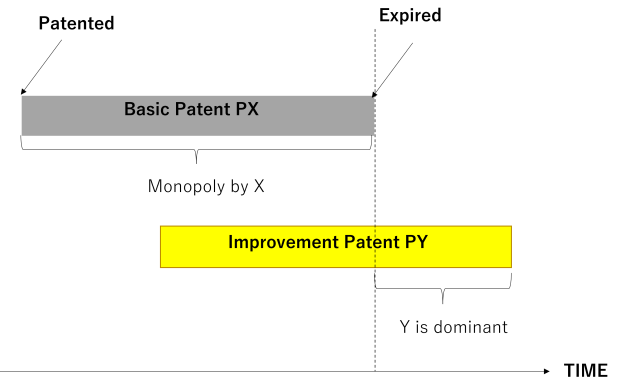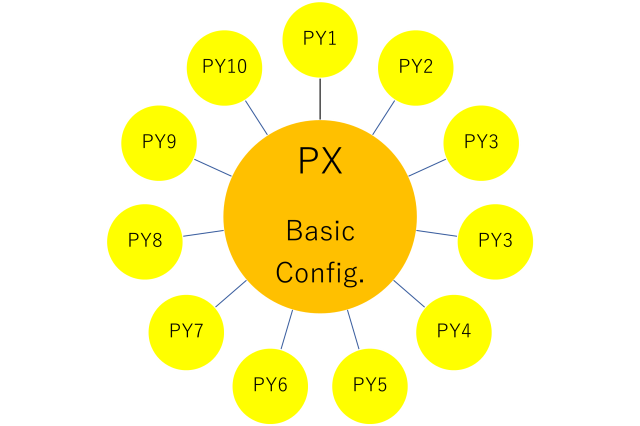Basic and Improvement Patents
Entirely new products or services open up entirely new markets.
A patent right that broadly protects a pioneer-type invention (basic invention) is called a “Basic Patent”.
Since the concept itself is new, a patent right with a broad scope of rights can be obtained.
Basic patents are absolutely necessary patents that must be used to manufacture the product.
If the basic invention is promising, many improvement inventions that arrange the basic invention will emerge.
A patent right covering an improvement invention is called an “Improvement Patent (peripheral patent)”.
The degree of improvement can vary from substantial to trivial.
It is a typical pattern of technological emergence that a breakthrough basic invention is followed by a vast number of improvement inventions.

Many of the inventions that come out of big companies are improvement inventions.
Many of the inventions that come out of universities and venture companies are basic inventions.
Basic inventions that open up new frontiers
As an example of a basic invention, suppose Company X first thought of a “bicycle".
Company X obtains Patent Right PX for a bicycle with two wheels, handlebars, pedals, and a saddle (hereinafter referred to as a “basic configuration bicycle“).
Since Company X conceived the concept of a bicycle for the first time in a world where bicycles do not exist, Patent Right PX is a basic patent.
Company X can exclusively sell bicycles by virtue of its Patent Right PX.
Improvement inventions to follow
Suppose that a few years later, Company Y comes up with the idea of attaching a light to a bicycle.
Company Y obtains Patent Right PY for “a bicycle with a light in addition to the basic configuration".
Since this invention is an improvement of the concept of a bicycle, Patent Right PY is an improvement patent of Patent Right PX.

Patent rights with conditions
Since Company X has the basic patent PX, it can continue to sell bicycles exclusively even if Company Y obtains the Improvement Patent PY.
However, Company X cannot install a light on the bicycle, because doing so would be an infringement of Improvement Patent PY.
Although it does not disturb the business, Company X needs to be concerned about the Patent PY.
On the other hand, Company Y cannot sell the bicycle even if it obtains the Improvement Patent PY.
To manufacture and sell a “bicycle with a light in addition to the basic configuration (Improvement Patent PY)” is to manufacture and sell a “bicycle with the basic configuration (Basic Patent PX)”.
In other words, the manufacture and sale of a product with an improvement invention is an infringement of the Basic Patent PX.
The Improvement Patent PY is said to “use” Basic Patent PX.
The Improvement Patent PY is a patent right with conditions that are constrained by the Basic Patent PX.
Company Y must ask Company X to allow it to use Basic Patent PX.
It is possible for Company Y to offer a deal in which Company Y is allowed to use Basic Patent PX in exchange for Company X's use of Improvement Patent PY, but Company X has the initiative in the negotiations.
Company Y needs the Basic Patent PX, but Company X does not need the Improvement Patent PY.
Turning the Tables
Eventually, when the Basic Patent PX expires, the monopoly period for bicycles by Company X will end.
Once the monopoly is over, anyone can make a “basic configuration bicycle”.

Company Y can exclusively sell “bicycles with lights in addition to the basic configuration” by virtue of the Improvement Patent PY.
Company X can manufacture and sell “bicycles with the basic configuration,” but not exclusively, nor can it install lights.
Since only Company Y can sell bicycles with lights, Company X's bicycles cannot compete with Company Y's bicycles in terms of merchantability.
Company X, which had been resting on its Basic Patent PX, loses the “bicycle market” it has created to Company Y.
Pressure from mass patents
Company Y may obtain a large number of patents for bicycle improvements.
For example, a large number of improvement inventions can be created from one basic invention, such as variations in the shape of pedals, material of handlebars, methods of repairing a flat tire, auxiliary wheels, reflectors for nighttime visibility, variations in the shape of reflectors....

If Company Y holds a large number of improvement patents on bicycles, it will be difficult for Company X to improve its bicycles.
Company X's attempts to improve the bicycle in any way may infringe on Company Y's improvement patents
Company Y can increase its bargaining power with Company X by obtaining a large number of improvement patents.
Company X should probably make an early decision to share the market with Company Y by licensing the basic patent PX to eliminate the threat of a large number of improvement patents.
Don't rest on your laurels with basic patents.
Company X should have continued to make improvements after inventing the bicycle and should have continued to obtain improvement patents in advance of Company Y.
Company X, the inventor of the bicycle, is in a position to notice the improvements that need to be made to the “basic bicycle configuration” before anyone else.
It is not enough to have a basic patent, but it is also necessary to continue to obtain patents for improvements after obtaining a basic patent in order to maintain the leading position.
In many cases, venture companies and universities obtain only one basic patent and end up with nothing more.
No matter how excellent the basic patent may be, if you remain complacent with the basic patent, your business foundation will eventually be undermined.
If you want to protect your position and reputation (brand) as a pioneer, you should continue to make improvements and steadily protect the small achievements that result from these improvements with improvement patents.